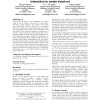Free Online Productivity Tools
i2Speak
i2Symbol
i2OCR
iTex2Img
iWeb2Print
iWeb2Shot
i2Type
iPdf2Split
iPdf2Merge
i2Bopomofo
i2Arabic
i2Style
i2Image
i2PDF
iLatex2Rtf
Sci2ools
BCSHCI
2007
2007
Voice art: investigating paralinguistic voice as a mode of interaction to create visual art
In this paper, we report on our investigation into people’s ability to use the volume of their voice to control cursor movement to create drawings. Early analysis of the results show changing the volume of the voice as an interaction method is a concept that is easily understood by users. People find changing the volume of their voice comfortable, natural and intuitive. With motivation, training and practice use of volume to control drawing tasks shows great promise. This is especially hopeful for artists with upper limb disabilities who show remarkable endurance, patience and determination to create art with whatever means available to them. We have also identified several design recommendations that may improve the control and performance of such a system. We believe that volume control has wider implications beyond assisting artists with upper limb disabilities. Some possible implications may be: as an alternative mode of interaction for disabled people to perform tasks other tha...
| Added | 29 Oct 2010 |
| Updated | 29 Oct 2010 |
| Type | Conference |
| Year | 2007 |
| Where | BCSHCI |
| Authors | Dharani Priyahansika Perera, R. T. Jim Eales, Kathy Blashki |
Comments (0)

